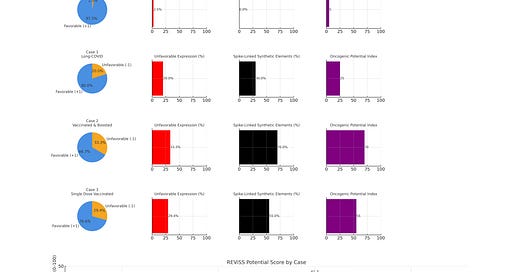Neo7’s REViSS Technology Uncovers Alarming mRNA Vaccine Risks
Signal-Based Medicine | mRNA Vaccine Injuries
As Neo7Bioscience and the University of North Texas Genomics and BioDiscovery Institute progress in their work on genetic safety and stability, focusing on mRNA vaccine-related injuries and complications, the following preliminary findings in the case study outlined below are alarmingly compelling. These results will be published soon.
The rollout of mRNA vaccines has been celebrated as a triumph of modern science but is far from it!
An alarming growing body of data suggests potential risks that cannot be ignored. A revealing chart titled *"Integrated REViSS Analysis: Hallmark Gene Expression, Synthetic Contamination, and Oncogenic Potential" uses the RNA Expression Variant Instability Signature Surveillance (REViSS) system to highlight significant biological aberrations in individuals who received mRNA vaccines. The results—particularly for those vaccinated with boosters or a single dose—point to heightened risks of genetic instability, synthetic contamination, and oncogenic potential. These findings raise serious questions about mRNA vaccine safety and demand immediate attention.
What is the REViSS System?
The REViSS system, or RNA Expression Variant Instability Signature Surveillance, is a framework designed to assess the biological impact of RNA-based interventions like mRNA vaccines. It measures three key indicators of systemic stress:
1. Unfavorable Hallmark Gene Expression (%): The proportion of disrupted gene expression linked to inflammation, immune dysregulation, or other adverse effects.
2. Spike-Elements and Synthetic Contaminants (%): The aberrant signal potential caused by synthetic contaminants, likely from mRNA vaccine production, such as nucleotide gene fragments (mtDNA 12S and globin structures, Poly A, SV40, etc), lipid nanoparticles or residual genetic material.
3. Oncogenic Potential Index: A measure of cancer risk due to cellular or genetic changes induced by the unstable transcription/translation shift.
The REViSS system evaluates these metrics across four cases:
- Case 0 (Normal Expression): A baseline with no vaccine or Long COVID exposure.
- Case 1 (Long COVID): Individuals with persistent symptoms post-COVID-19 infection.
- Case 2 (Vaccinated & Boosted): Individuals who received an mRNA vaccine and a booster.
- Case 3 (Single Dose Vaccinated): Individuals who received one dose of an mRNA vaccine.
The REViSS score integrates these metrics into a single risk value, with higher scores indicating greater RNA expression instability and systemic harm.
Troubling Findings Across the Cases
The chart above reveals significant aberrations in vaccinated individuals (Cases 2 and 3) compared to the baseline (Case 0) and Long COVID (Case 1). Here’s what the data shows:
1. Unfavorable Hallmark Gene Expression:
- Case 0 (Normal): 2.5% unfavorable expression (97.5% favorable).
- Case 1 (Long COVID): 20% unfavorable expression, showing moderate disruption.
- Case 2 (Vaccinated & Boosted): 33.3% unfavorable expression, the highest observed.
- Case 3 (Single Dose Vaccinated): 29.4% unfavorable expression, also elevated.
Vaccinated individuals exhibit a marked increase in unfavorable gene expression, suggesting potential immune dysregulation or chronic inflammation triggered by mRNA vaccines.
2. Spike-Linked Synthetic Elements Aberrations:
- Case 0 (Normal): 0% synthetic elements.
- Case 1 (Long COVID): 30%, aberrations initiated by the SARS-CoV2 Viral Spike-Elements.
- Case 2 (Vaccinated & Boosted): A concerning projected 70% faulty signal-potential caused by synthetic Spike-element aberrations from mRNA vaccination.
- Case 3 (Single Dose Vaccinated): A concerning projected 55% faulty signal-potential caused by synthetic Spike-element aberrations from mRNA vaccination.
The high levels of synthetic elements in vaccinated individuals raise alarms about mRNA vaccine manufacturing quality or the persistence of vaccine components in the body, which could lead to toxicity, immune reactions, cancer, and other life-threatening complications.
3. Oncogenic Potential Index:
- Case 0 (Normal): A low index of 5.
- Case 1 (Long COVID): A moderately elevated index of 25.
- Case 2 (Vaccinated & Boosted): A serious, alarming index of 70.
- Case 3 (Single Dose Vaccinated): A concerning high index of 55.
The oncogenic potential index indicates a significantly elevated cancer risk in vaccinated individuals, particularly those with boosters, possibly due to chronic inflammation, interference with tumor suppressor genes, or unintended genetic changes.
4. REViSS Score:
- Case 0 (Normal): 2.5, a negligible risk.
- Case 1 (Long COVID): 17.3, indicating moderate instability resulting from the SARS-CoV2 chronic infection.
- Case 2 (Vaccinated & Boosted): 41.3, a major red flag.
- Case 3 (Single Dose Vaccinated): 33.1, also alarming.
The REViSS score, which quantifies RNA expression variant instability, shows that vaccinated individuals face systemic risks up to 16 times higher than the baseline, with the highest risk in those vaccinated and boosted.
What This Means for mRNA Vaccine Safety
The REViSS system’s findings are deeply concerning:
- Vaccinated individuals show the highest levels of RNA expression instability, synthetic contamination, and oncogenic potential. This suggests that mRNA vaccines may cause widespread biological disruptions, potentially leading to chronic health issues.
- Synthetic contaminants are a critical issue. The alarming signal aberrations of spike-linked synthetic elements in 55–70% of vaccinated individuals point to potential manufacturing flaws and the intended engineering of vaccine components.
- The oncogenic potential is alarming. An index of 70 in vaccinated and boosted individuals raises the specter of long-term cancer risk, a concern that requires urgent investigation. - Even a single dose carries significant risk. With a REViSS score of 33.1, single-dose vaccinated individuals still face over 13 times the risk of the baseline.
A Call for Transparency and Further Research
Health authorities and vaccine manufacturers must prioritize transparency and comprehensive post-marketing surveillance. mRNA vaccine technology is critically flawed and life-threatening, and individuals must be informed of these potential risks and life-threatening complications.
Conclusion
The RNA Expression Variant Instability Signature Surveillance (REViSS) system has revealed alarming risks associated with mRNA vaccines, with vaccinated and boosted individuals showing a REViSS score of 41.3—over 16 times higher than the normal baseline of 2.5. From significant RNA expression instability and chaotic aberrations caused by synthetic Spike- elements and contaminants with an alarming risk of oncogenic potential, the data suggests that mRNA vaccines pose substantial life-threatening health risks.
The differential RNA abundance across hallmark gene expression pathways reflects active cell-to-cell transmission via retranscription and persistent extracellular vesicle signaling. Simultaneously, the elevated oncogenic mutation burden strongly indicates genomic integration and associated somatic mutagenesis.
Inquiries:










And with this and many other studies the FDA in their total ignorance for safety have still allowed these “vaccines” to be given to even the youngest children….seeding them with a very ugly future indeed. In the least these vacs must be suspended until we have more finality which at this point should then BAN these products immediately. To not suspend this appalling display of child abuse is criminal!
interesting article Dr Catanzaro, thank you
it will provoke many questions (I have many)
.. I will sit back and watch the PhDs and Medicos fly first